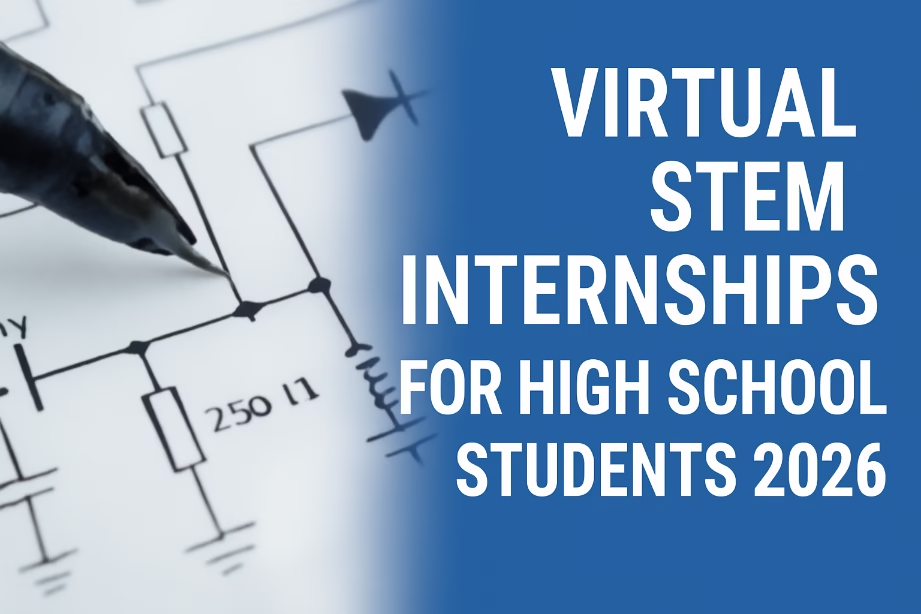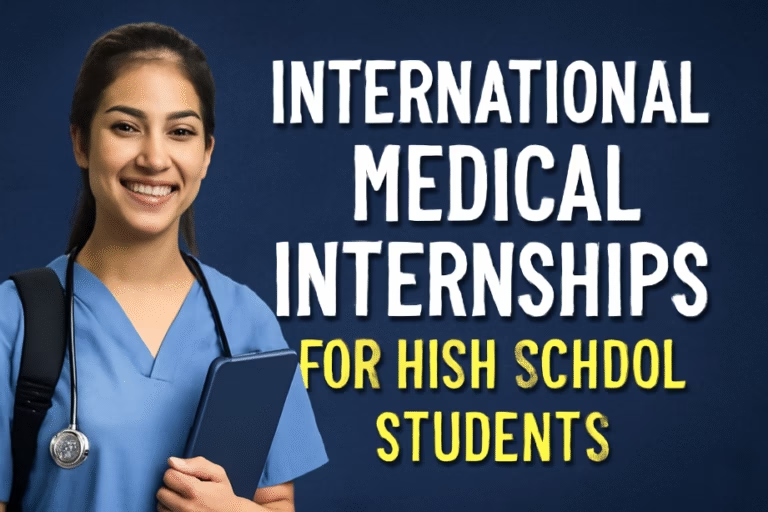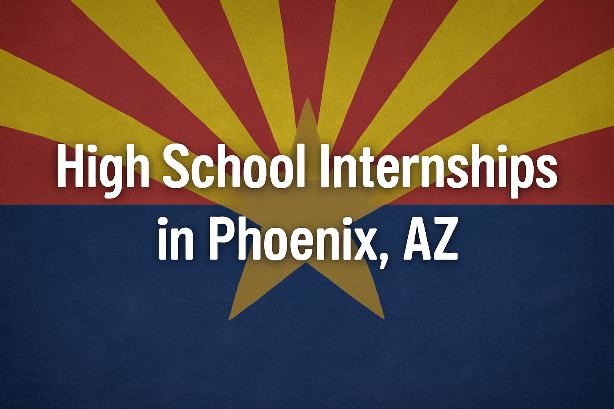15 Best Virtual STEM Internships for High School Students 2026
Virtual STEM Internships for High School Students 2026
Virtual STEM internships give motivated high school students an early edge: hands-on projects, mentorship from working scientists and engineers, real deliverables for college applications, and exposure to remote collaboration tools that modern workplaces expect. In 2026, the range of high-quality remote opportunities continues to expand — from space science and AI to bioinformatics and renewable energy. This guide lists 15 trusted virtual STEM internships, each with an official program link, clear eligibility notes, stipend or fee information, location (virtual), and common application windows. Use this as a practical roadmap to choose programs that match your interests, availability, and budget.
Why virtual STEM internships matter
Virtual internships make advanced STEM learning more accessible: students who cannot travel or who prefer remote study can still participate in meaningful research, data analysis, and engineering design. These programs help you build technical skills (coding, data analysis, lab technique simulations), communication skills (presentations, technical writing), and a portfolio of real-world projects that strengthen college and scholarship applications.
How to use this list
Read the program descriptions to match your interests (AI, biology, engineering), confirm eligibility on the official page, and track application deadlines carefully. Some programs are free and offer stipends; others are tuition-based but include strong mentorship, review opportunities, and recommendation letters. If your focus is computer science, consider the computer science cohorts below; if you want lab-adjacent bio experience, check the NASA and bioinformatics entries.

Top 15 virtual STEM internships for high school students — 2026
1. NASA High School Aerospace Scholars (HAS)
Official link: https://www.nasa.gov/stem/
Description: HAS pairs high school students with NASA engineers and scientists for virtual STEM modules, team design projects, and live webinars. It is focused on aerospace, systems engineering, and space science education.
Requirements: Typically U.S. residents or citizens; high school grade-level requirements vary by year. Check the official page for eligibility.
Paid/Unpaid: Unpaid educational program; no stipend, but highly prestigious.
Location: Virtual (some regional culminating events may be in-person when available).
Timeline: Applications commonly open in late winter/early spring; deadlines vary by cycle.
2. Google Computer Science Summer Institute (CSSI) — Online option
Official link: https://buildyourfuture.withgoogle.com/programs/computer-science-summer-institute
Description: CSSI is an immersive introduction to computer science and software engineering. The program includes pair programming, problem solving, and a final project under mentor guidance.
Requirements: Often targeted at rising college students or high school seniors intending to major in CS; check the current year eligibility on the official site.
Paid/Unpaid: Historically CSSI offers stipends or paid components depending on cohort; check the program page for the most recent details.
Location: Virtual and in-person cohorts in prior years.
Timeline: Applications typically open in winter and close by spring.
3. Smithsonian Learning Lab — Virtual Research & Projects
Official link: https://learninglab.si.edu
Description: The Smithsonian provides remote research modules, data curation projects, and mentor interactions across disciplines — natural history, conservation science, digital humanities, and STEM.
Requirements: Open to high school students worldwide for many modules; program prerequisites vary by offering.
Paid/Unpaid: Free educational resources; some project tracks may be part of paid summer academies.
Location: Fully virtual.
Timeline: Many modules accept rolling enrollment; formal summer programs have set dates posted on the site.
4. The Forage — Engineering and Tech Virtual Experiences
Official link: https://www.theforage.com
Description: The Forage hosts employer-designed virtual work experience programs that simulate engineering, data, and product design tasks. Students complete real company-style projects and receive completion certificates and feedback.
Requirements: No strict grade requirements; ready to learn and commit to self-paced modules.
Paid/Unpaid: Free; certificate of completion.
Location: Remote, self-paced.
Timeline: Available year-round; apply/ enroll any time.
5. Veritas AI — Remote AI/ML Internship Pathways for Teens
Official link: https://www.veritasai.com
Description: Veritas AI offers structured AI/ML pathway programs and remote internships that pair students with mentors to work on data projects, modeling, and applied machine learning tasks with portfolio-ready outcomes.
Requirements: Prior programming basics recommended (Python), strong interest in AI/ML, and willingness to engage in weekly mentor calls.
Paid/Unpaid: Program fees apply for some cohorts; scholarships and financial aid may be available.
Location: Virtual.
Timeline: Cohorts run on scheduled terms — check the site for exact enrollment windows.
6. Horizon Academic Research Program — Remote STEM Research
Official link: https://horizoninspires.com
Description: Horizon runs virtual research programs for high school students in data science, biology, and engineering. Projects include mentor guidance, project deliverables, and letter(s) of recommendation on completion.
Requirements: Competitive academics and a demonstrated interest in scientific research; rising 10th–12th graders often prioritized.
Paid/Unpaid: Program fees apply; need-based aid and scholarships available in many cycles.
Location: Virtual.
Timeline: Application windows typically in late fall through winter for summer cohorts.
7. Johns Hopkins (CTY / Pre-College) — Virtual Neuroscience and STEM Modules
Official link: https://cty.jhu.edu
Description: Johns Hopkins Center for Talented Youth and JHU Pre-College programs periodically offer virtual research modules and STEM internships focused on brain science, bioinformatics, and engineering design.
Requirements: Varies by offering — many virtual tracks are open to motivated high school students with strong academics.
Paid/Unpaid: Fee-based for many pre-college offerings; partial scholarships available for qualified students.
Location: Virtual (with optional on-campus tracks for certain programs).
Timeline: Applications commonly open in autumn and close in winter/early spring.
8. NASA GeneLab for High Schools (GL4HS) — Bioinformatics & Space Biology
Official link: https://genelab.nasa.gov
Description: GL4HS engages students with authentic space biology datasets. High school interns learn genomics workflows, data analysis, and visualization while contributing to genuine scientific questions.
Requirements: Strong interest in biology/computation; some programs require basic biology coursework.
Paid/Unpaid: Many GL4HS opportunities are free; some cohorts provide stipends for selected participants.
Location: Virtual.
Timeline: Cohorts run seasonally; consult the GeneLab education pages for cycle details.
9. Virtual Student Federal Service (VSFS)
Official link: https://vsfs.state.gov
Description: VSFS connects students with U.S. federal agency projects that include technical research, data analysis, and STEM policy support. These are remote service opportunities where students contribute to agency missions.
Requirements: Often U.S. citizenship is required for VSFS; check agency-specific eligibility. High school students may be eligible for some placements, though many roles target college students.
Paid/Unpaid: Unpaid (volunteer service), but provides outstanding professional experience and references.
Location: Virtual.
Timeline: Annual application cycles; announcement windows are published on the VSFS portal in late winter/spring.
10. George Mason University — ASSIP (Virtual Research Tracks)
Official link: https://summer.gmu.edu/programs/assip
Description: George Mason University’s summer research and STEM immersion programs sometimes provide virtual options in computer science, environmental science, and cognitive science for high school students.
Requirements: Age and grade thresholds apply (generally 15+); selection is based on interest and prior coursework.
Paid/Unpaid: Fee-based; need-based aid or waivers may be available.
Location: Virtual or hybrid depending on the year.
Timeline: Applications usually open in fall/winter for the next summer term.
11. Energy & Sustainability Virtual Internships — Selected Publishers and Nonprofits
Official link (example provider): Check reputable outlets such as U.S. Department of Energy Student Programs and nonprofit publishers that run remote projects.
Description: Remote internships in renewable energy analytics, grid modeling, and sustainability reporting. Projects produce policy briefs, data analyses, or coded models used by partner NGOs.
Requirements: Basic background in math, science, or data analysis; interest in climate/energy topics.
Paid/Unpaid: Varies — some government programs provide stipends, many nonprofit projects are unpaid but may offer published outputs.
Location: Virtual.
Timeline: Often posted seasonally; check agency or NGO listings in fall–spring.
12. Stanford AIMI / SHTEM Virtual Research Modules
Official link: https://summer.stanford.edu (look for AI & Medicine, SHTEM modules)
Description: Stanford’s summer offerings include short virtual research intensives in AI for medicine and interdisciplinary STEM/humanities projects. Students work in teams on mentored research and present findings.
Requirements: Academic excellence and prior coursework depending on the module.
Paid/Unpaid: Programs are usually tuition-based; scholarships may be available.
Location: Virtual or hybrid.
Timeline: Application windows typically fall–winter for summer sessions.
13. Columbia University — Virtual Summer Research Program
Official link: https://sps.columbia.edu/precollege
Description: Columbia School of Professional Studies and other Columbia units occasionally provide supervised virtual research assistantships in data science and programming for talented high school students.
Requirements: Selective; applicants often need strong academic records and a demonstrated interest in research.
Paid/Unpaid: Varies by program year; some tracks include fee waivers or scholarships.
Location: Virtual.
Timeline: Summer cohorts; check site for exact deadlines (usually winter–spring).
14. Ladder Internships — Remote Tech & Startup Internships
Official link: https://ladderinternships.com
Description: Ladder organizes cohort-based remote internships that pair high school and gap-year students with startup projects in product design, software engineering, and data analytics. Students deliver MVPs and demo to partner companies.
Requirements: Motivation to work in a team, some technical experience preferred (varies by role).
Paid/Unpaid: Some cohorts are paid or provide stipends; others are tuition-based with outcome guarantees.
Location: Remote.
Timeline: Multiple cohorts run year-round; check the site for next applications.
15. CodeDay Labs — Virtual Software Engineering Internships
Official link: https://www.codeday.org/labs
Description: CodeDay Labs places high school students in remote, mentored software engineering projects where they work on open-source repositories or build production-grade tools with feedback from industry mentors.
Requirements: Some coding experience preferred; open to beginners with solid motivation.
Paid/Unpaid: Typically free or low-cost; scholarships may be available.
Location: Virtual.
Timeline: Rolling admissions for many project cycles; specific lab dates posted on CodeDay’s site.

Choosing the right virtual STEM internship
When selecting a remote internship, consider three core factors:
- Project substance: Prioritize programs that result in a tangible deliverable — code, a research poster, or a technical report — rather than passive lecture series.
- Mentorship: Programs offering regular mentor check-ins and feedback accelerate learning and provide stronger recommendation letter opportunities.
- Time and cost: Evaluate whether the weekly time commitment fits your school schedule and whether program fees are reasonable or if scholarship support is available.
Application tips
- Start early: Many competitive virtual STEM programs have application windows in the fall or winter for summer cohorts.
- Polish your materials: Prepare a concise personal statement that emphasizes a project idea or problem you want to solve, along with a short portfolio (GitHub, project PDFs, or lab notes).
- Request strong recommendations: Ask STEM teachers who know your work to provide specific examples of your skills and curiosity.
- Prepare for interviews: Some programs use brief interviews to assess motivation and fit — have a few examples of technical challenges you’ve tackled.
- Leverage free preparatory resources: If a program expects basic coding or biology knowledge, complete short online courses or Forage modules to demonstrate readiness.
What you’ll learn — skill checklist
Completing a virtual STEM internship helps you build:
- Programming (Python, JavaScript, R) and data analysis skills
- Scientific reasoning, experimental design, and statistics
- Remote collaboration: version control, virtual standups, and professional communication
- Presentation skills: technical posters, slide decks, and demo videos
Frequently Asked Questions (FAQs)
1. Can international students apply to these virtual internships?
Yes. Many virtual internships are open globally (e.g., The Forage, Smithsonian Learning Lab, Veritas AI). Programs tied to U.S. federal agencies (like VSFS) or certain funded opportunities may have citizenship or residency requirements — always check the official eligibility criteria on the program page.
2. Are virtual STEM internships recognized by colleges?
Absolutely. Admissions officers value project-based experience, mentorship, and concrete outcomes. A completed internship where you can point to a GitHub repo, poster, or technical writeup can be more persuasive than a generic extracurricular line.
3. How much time should I expect to commit?
Expect between 5–15 hours per week for most virtual programs. Intensive cohort models may require full-time weeks for short sprints (e.g., 20–30 hours for 1–2 week bootcamps).
4. Are virtual internships worth paying for?
Paid programs can be worth the investment if they include high-quality mentorship, portfolio outputs, and support for college letters of recommendation. However, many high-value free options exist (e.g., The Forage, some NASA modules, Smithsonian resources).
5. How do I show virtual internship experience on applications?
List the internship under “Experience” or “Research” with a 2–3 line description that highlights your project, your specific contributions, tools used, and outcomes (e.g., “Built an image classifier with Python; achieved 85% accuracy; code on GitHub; presented final poster to mentors”).
6. Can virtual internships lead to paid jobs or research opportunities?
Yes. Strong remote internship performance can translate into extended mentorship, follow-on research opportunities, paid micro-internships, or introductions to college research groups and startup founders.
7. What about accessibility and equitable access?
Many providers offer scholarships or fee waivers. If cost is a barrier, search for funded programs (university initiatives, NASA education modules) or contact program coordinators to ask about financial support.
Next steps and resources
Ready to apply? Start by shortlisting 3 programs that match your interest and availability. Prepare a focused personal statement and a simple portfolio. If you need remote CS practice, try The Forage or CodeDay Labs first to build confidence. For research and bioinformatics, explore NASA GeneLab and Horizon’s remote research cohorts.
If you’re also exploring paid remote options or subject-specific internships, check related posts on topics like Paid Remote Internships for High School Students 2026, Online Paid Internships for High School Students 2026, Biotechnology Summer Programs for High School Students 2026, and Computer Science Internships.









